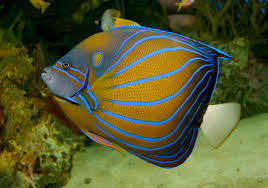
 written by Charles Bird
written by Charles Bird
Fish and Marine Creatures of The Andaman and Gulf Of Thailand.
Today we look at the Angel fish. These stunning fish can be found all over the world and are very plentiful and the waters around Phuket Thailand are home to many different types. The really confusing thing to take note of with these fish is they change colours and patters as they get older. The Juvenile can to totally different to the adult so to be honest a book with these in is always a must when diving or you will always assume you have found a new fish when its just a juvenile. All the dive sites in Thailand Phuket more than many has so many types that all boats will have a fish guidebook onboard for sure. This applies to the Similan islands too. Due to the location of the Similans the fish we can get there can be so varied as they can wander over from the Andaman islands or even across the Indian ocean. The waters of the Andaman ocean and the Gulf of Thailand are warm and clear for most of the year which makes the fish life here so colourful that scuba diving Thailand is getting more and more popular. For those scuba diving Phuket the choice is almost endless when it comes to what you can see and where you can dive. For those people scuba diving Phuket between mid October and mid May then you really must have a glance at a Similan liveaboard. The can be arranged through any good Phuket dive center. These trips can be anything from overnight to a week or even longer. Once you are diving in the Similan island or Surin islands national parks then you will not want to return and will need to go back as you will never see it all.
Ok so back to the Angle fish.
Marine angelfish are perciform fish of the family Pomacanthidae. They are found on shallow reefs in the tropical Atlantic, Indian, and mostly western Pacific oceans. The family contains seven genera and approximately 86 species.
They should not be confused with the freshwater angelfish, tropical cichlids of the Amazon River basin.
With their vibrant colours and deep, laterally compressed bodies, marine angelfishes are some of the more conspicuous residents of the reef. They most closely resemble the butterflyfishes, a related family of similarly showy reef fish.
Marine angelfish are distinguished from butterflyfish by the presence of strong preopercle spines (part of the gill covers) in the former. This feature also explains the family name Pomacanthidae; from the Greek poma meaning "cover" and akantha meaning "thorn".
Many species of marine angelfishes have streamer-like extensions of the soft dorsal and anal fins. The fish have small mouths, relatively large pectoral fins and rounded to lunate tail fins. The largest species, the gray angelfish, Pomacanthus arcuatus, may reach a length of 60 cm; at the other extreme, members of the genus Centropyge do not exceed 15 cm. A length of 20 to 30 cm is average for the rest of the family.
The smaller species are popular amongst aquarists, whereas the largest species are occasionally sought as a food fish; however, there have been reports of ciguatera poisoning as a result of eating marine angelfish. The larger species are also quite bold and seemingly fearless; they are known to approach divers. While the majority adapt easily to captive life, some are specialist feeders which are difficult to maintain.
Feeding habits can be strictly defined through genus, with Genicanthus species feeding on zooplankton and Centropyge preferring filamentous algae. Other species focus on sessile benthic invertebrates; sponges, tunicates, bryozoans, and hydroids are staples.
Most marine angelfishes restrict themselves to the shallows of the reef, seldom venturing deeper than 50 meters. The recently described Centropyge abei is known to inhabit depths of 150 m. They are diurnal animals, hiding amongst the nooks and crevices of the reef by night.
Some species are solitary in nature and form highly territorial mated pairs; others form harems with a single male dominant over several females. As juveniles, some species may eke out a living as cleaner fish.
Common to many species is a dramatic shift in coloration associated with maturity. For example, young male ornate angelfish, Genicanthus bellus, have broad, black bands and are indistinguishable from females; as they mature, bright orange bands develop on the flanks and back. Thought to correspond to social rank, these colour shifts are not necessarily confined to males, all marine angelfish species are known to be protogynous hermaphrodites. This means that if the dominant male of a harem is removed, a female will turn into a functional male.
As pelagic spawners, marine angelfishes release many tiny buoyant eggs into the water which then become part of the plankton. The eggs float freely with the currents until hatching, a high number falling victim to planktonic feeders.
The Queen angelfish, arguably the most beautiful species of angelfish, grows to be 45 cm. With neon blue and yellow scales, with iridescent purple and orange markings, surprisingly it is not conspicuous, and actually hides very well, and is very shy.
The great thing when in Phuket diving that the fish are used to seeing divers as we are always very careful not to harm them or disturb them in anyway. This applies when in the Similan islands diving too as being a marine national park good diving practices are take very seriously. No feeding, chasing, touching or disturbing the wildlife at all and that includes the sand too. No holding the corals or even rocks with life on it is not acceptable to any good dive center. This means that even the shyest of creatures can be see quite often. This is why the diving and the many Phuket snorkel tours have so much to offer. A trip diving or snorkeling in Phuket Thailand is a highlight of any trip to SE Asia.
Tags:
-
-
-
-
-
Thailand Diverssimilan divingphuket scuba diving. similanssimilan islands














Load more comments